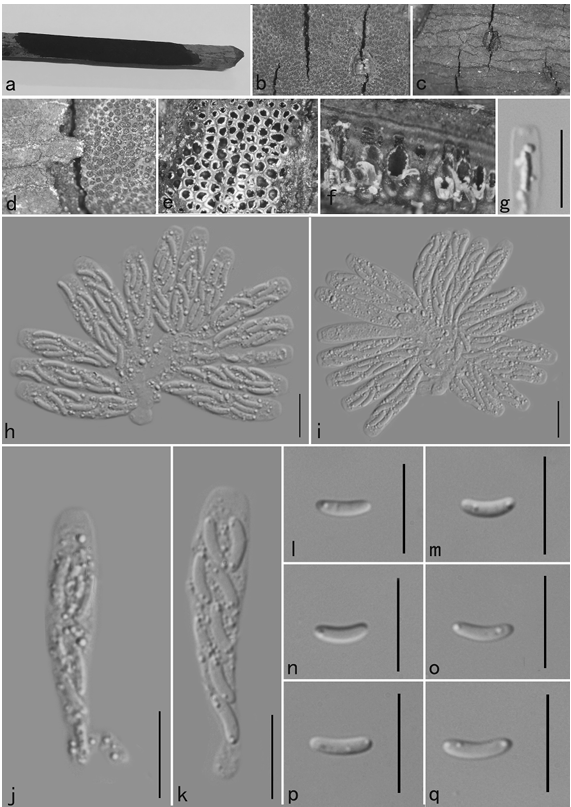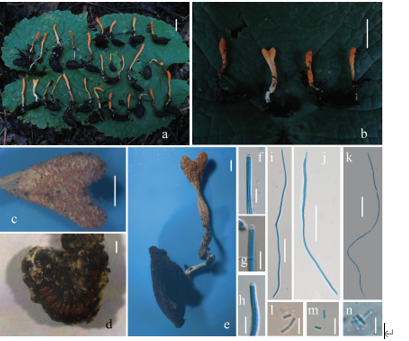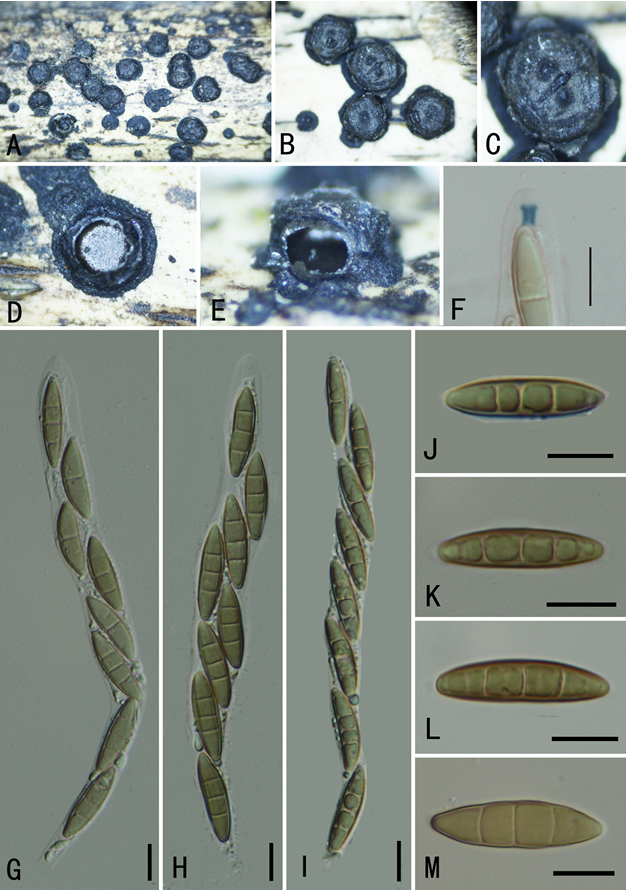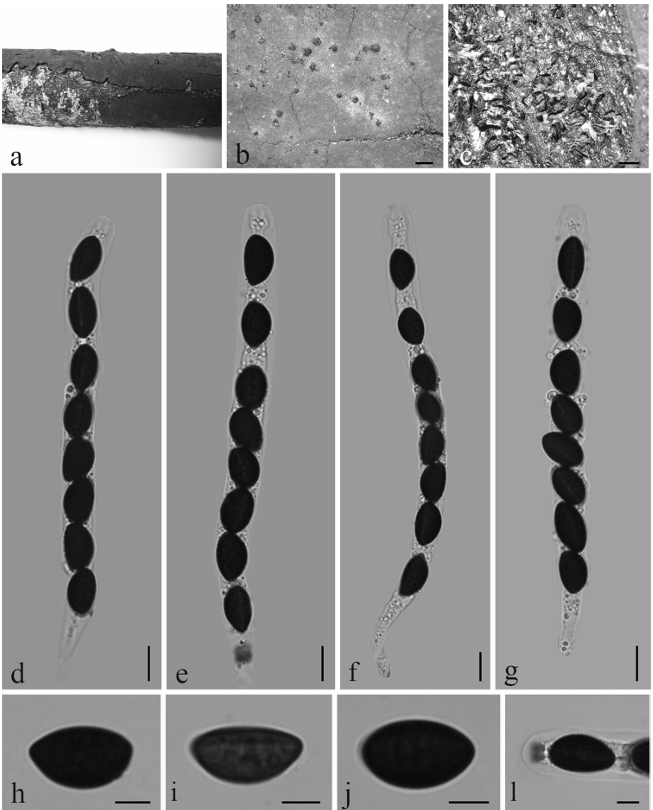Aquihelicascus yunnanensis W. Dong, H. Zhang & K.D. Hyde, sp. nov.2020
Index Fungorum number: IF557921; Facesoffungi number: FoF09263
Holotype: CHINA, Yunnan Province, Dehong, on submerged wood in a stream, 25 November 2017, G.N. Wang, H35A-1 (MFLU 18-1170, holotype), ex-type living culture MFLUCC 18-1025; ibid., H35A-2 (HKAS 101719, isotype), ex-type living culture KUMCC 18-0069.
Morphological description
Saprobic on decaying wood submerged in freshwater. Sexual morph: Pseudostromata 150–180 μm high, 420–480 μm diam., scattered, comprising brown to black fungal tissues growing in cortex of host, uniloculate, lenticular, immersed with blackened ostiolar dots on the host surface. Ostiole central, opening rounded, periphysate. Peridium 15–25 μm thick, comprising several layers of brown to dark brown, thin-walled, compressed, elongate cells of textura angularis, pale brown to hyaline inwardly. Pseudoparaphyses 1.5–2.5 μm diam., numerous, cellular, hypha-like, short, hyaline, sparsely septate, unbranched. Asci 120–140 × 13.5–19 μm ( x̄ = 132 × 17 μm, n = 10), 8-spored, bitunicate, clavate, apically narrowly rounded, with a distinct, trapezoidal chamber, long pedicellate, up to 40 μm. Ascospores 25–28 × 9–10.5 μm ( x̄ = 27 × 10 μm, n = 10), biseriate, ellipsoidal, rounded at both ends, straight or slightly curved, hyaline, 1-septate, constricted at the septum, symmetrical, guttulate, two prominent guttules near the septa and with additionally smaller ones beside, smooth, thin-walled, lacking a mucilaginous sheath. Asexual morph: Undetermined.Culture characteristics: On PDA, colony circular, reaching 5 mm in 15 days at 25 °C, white to grey from above, brown from below, surface rough, fluffy, with dense mycelium, dry, raised, edge entire.
Habitat: on submerged wood in a stream
Distribution: CHINA, Yunnan Province, Dehong,.
GenBank Accession: MFLU 18-1170
Notes: Aquihelicascus yunnanensis clusters with A. songkhlaensis in our multigene phylogenetic analysis (Fig. 84). However, the number of locules in pseudostromata, single gene comparison (see notes under A. songkhlaensis) and phylogenetic analysis (Fig. 84) separate them to be different species.
Aquihelicascus yunnanensis is morphologically similar to A. thalassioideus in having clavate asci, and ellipsoidal, hyaline, 1-septate, guttuate ascospores (Zhang et al. 2013a). However, A. yunnanensis has a thinner peridium (15–25 μm vs. 70 μm) than A. thalassioideus. There are 10 and 32 nucleotide differences in LSU and ITS sequence data between A. yunnanensis (MFLUCC 18-1025) and A. thalassioideus (MFLUCC 10-0911), respectively, which indicates them to be different species. Key to freshwater Aquihelicascus species
Reference: Freshwater Dothideomycetes are a highly diverse group of fungi, which are mostly saprobic in freshwater habitats worldwide. They are important decomposers of submerged woody debris and leaves in water. In this paper, we outline the genera of freshwater Dothideomycetes with notes and keys to species. Based on multigene analyses and morphology, we introduce nine new genera, viz. Aquimassariosphaeria, Aquatospora, Aquihelicascus, Fusiformiseptata, Neohelicascus, Neojahnula, Pseudojahnula, Purpureofaciens, Submersispora; 33 new species, viz. Acrocalymma bipolare, Aquimassariosphaeria kunmingensis, Aquatospora cylindrica, Aquihelicascus songkhlaensis, A. yunnanensis, Ascagilis submersa, A. thailandensis, Bambusicola aquatica, Caryospora submersa, Dictyocheirospora thailandica, Fusiformiseptata crocea, Helicosporium thailandense, Hongkongmyces aquaticus, Lentistoma aquaticum, Lentithecium kunmingense, Lindgomyces aquaticus, Longipedicellata aquatica, Neohelicascus submersus, Neohelicomyces dehongensis, N. thailandicus, Neohelicosporium submersum, Nigrograna aquatica, Occultibambusa kunmingensis, Parabambusicola aquatica, Pseudoasteromassaria aquatica, Pseudoastrosphaeriella aquatica, Pseudoxylomyces aquaticus, Purpureofaciens aquatica, Roussoella aquatica, Shrungabeeja aquatica, Submersispora variabilis, Tetraploa puzheheiensis, T. yunnanensis; 16 new combinations, viz. Aquimassariosphaeria typhicola, Aquihelicascus thalassioideus, Ascagilis guttulaspora, A. queenslandica, A. seychellensis, A. sunyatsenii, Ernakulamia xishuangbannaensis, Neohelicascus aquaticus, N. chiangraiensis, N. egyptiacus, N. elaterascus, N. gallicus, N. unilocularis, N. uniseptatus, Neojahnula australiensis, Pseudojahnula potamophila; 17 new geographical and habitat records, viz. Aliquandostipite khaoyaiensis, Aquastroma magniostiolata, Caryospora aquatica, C. quercus, Dendryphiella vinosa, Ernakulamia cochinensis, Fissuroma neoaggregatum, Helicotruncatum palmigenum, Jahnula rostrata, Neoroussoella bambusae, N. leucaenae, Occultibambusa pustula, Paramonodictys solitarius, Pleopunctum pseudoellipsoideum, Pseudocapulatispora longiappendiculata, Seriascoma didymosporum, Shrungabeeja vadirajensis and ten new collections from China and Thailand, viz. Amniculicola guttulata, Aquaphila albicans, Berkleasmium latisporum, Clohesyomyces aquaticus, Dictyocheirospora rotunda, Flabellascoma fusiforme, Pseudoastrosphaeriella bambusae, Pseudoxylomyces elegans, Tubeufa aquatica and T. cylindrothecia. Dendryphiella phitsanulokensis and Tubeufa roseohelicospora are synonymized with D. vinosa and T. tectonae, respectively. Six orders, 43 families and 145 genera which belong to freshwater Dothideomycetes are reviewed. Of these, 46 genera occur exclusively in freshwater habitats. A world map illustrates the distribution of freshwater Dothideomycetes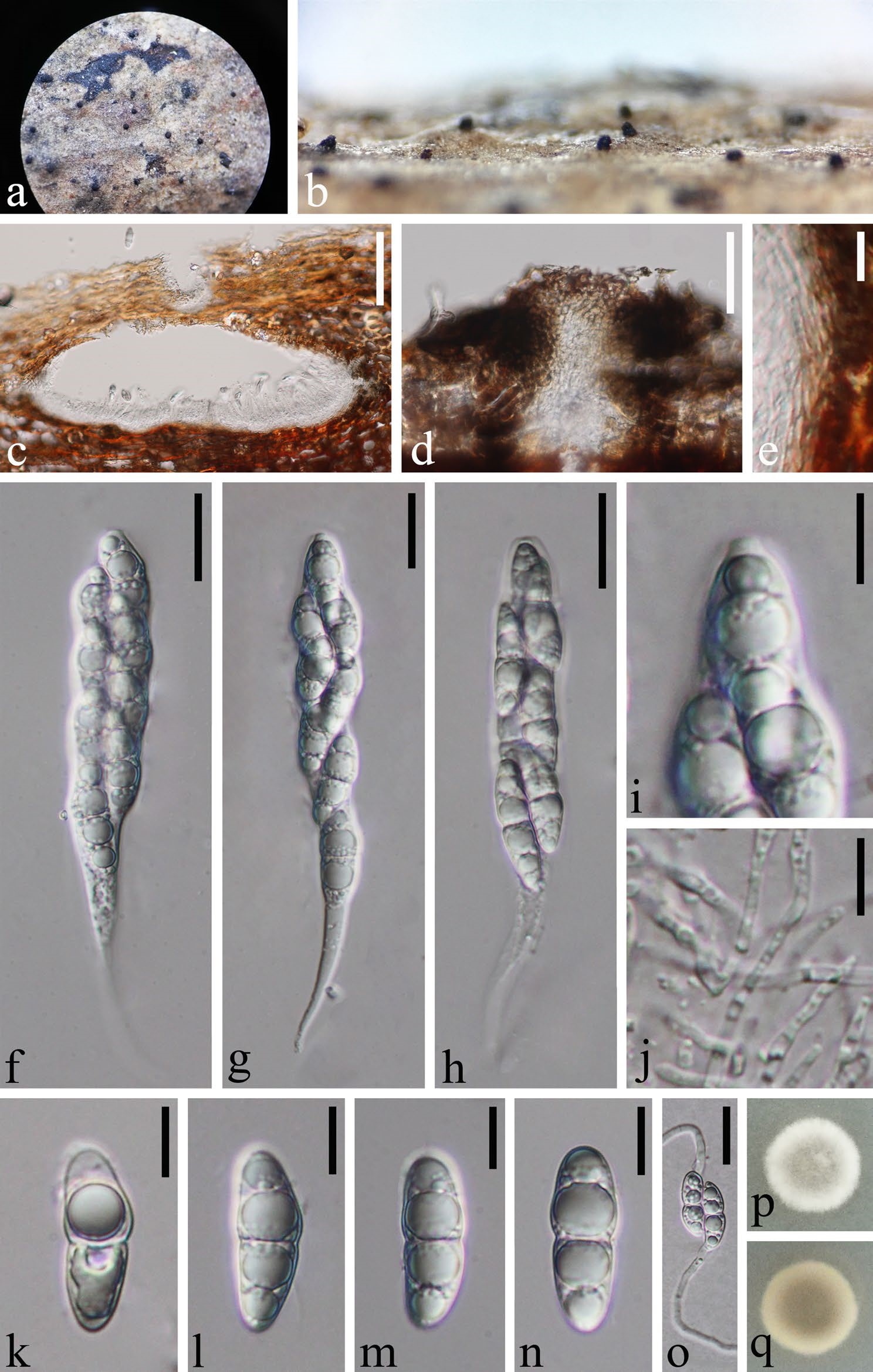
Fig. 80 Aquihelicascus yunnanensis (MFLU 18-1170, holotype). a, b Immersed ascomata with blackened ostiolar dots on the host surface. c Vertical section of ascoma. d Structure of ostiole. e Structure of peridium. f–i Bitunicate asci. j Pseudoparaphyses. k–n Ascospores. o Germinated ascospores. p Colony on PDA (up-front, down-reverse). Scale bars: c = 100 μm, d = 50 μm,


